Walter Elmer Schofield
| W. Elmer Schofield | |
|---|---|
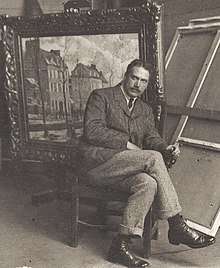 Schofield in his studio at St. Ives, Cornwall, 1907 | |
| Born |
September 10, 1867 Philadelphia, Pennsylvania, U.S.A. |
| Died |
March 1, 1944 (aged 76) Breage, Cornwall, England |
| Nationality | American |
| Education |
Pennsylvania Academy of the Fine Arts Académie Julian |
| Known for |
Landscape art Maritime art |
| Movement | Pennsylvania Impressionism |
Walter Elmer Schofield (September 10, 1867 – March 1, 1944) was an American Impressionist landscape and marine painter.
His body of work includes autumnal landscapes and snow scenes of Pennsylvania and New England, and summery landscapes and marine paintings of England and France.[1] Late in his career, he painted vividly-colored landscapes of the American Southwest.[2]:495 Although Schofield never lived in New Hope or Bucks County, he is regarded as one of the Pennsylvania Impressionists.[3]
Biography
W. Elmer Schofield (pronounced "SKŌ-field") was the youngest of the eight children of Philadelphia businessman Benjamin Schofield (1820–1900)[4] and Mary Wollstonecraft Schofield (1822–1899).[5] His parents emigrated from England to Philadelphia in 1845, and his father and uncles built textile mills in Manayunk, along the Schuylkill River.[6] He grew up in the Germantown section of Philadelphia, and graduated from Central High School in 1886.[7] He attended Swarthmore College for a year,[8] before dropping out and working as a cowboy in San Antonio, Texas.[2]:494 He studied at the Pennsylvania Academy of the Fine Arts, 1889–92, under Thomas Anshutz and Robert Vonnoh.[2]:495 He moved to Paris in 1892, and studied at the Académie Julian under William Bouguereau, Gabriel Ferrier, and Henri Lucien Doucet.[9]
Schofield returned to Philadelphia at the end of 1894,[8] and worked in his father's textile business for a short time, before committing to making his career in art.[10] Robert Henri, a fellow PAFA alumnus, was teaching at the Philadelphia School of Design for Women. Schofield was among a group of artists – William Glackens, Edward Willis Redfield, John French Sloan, Everett Shinn, George Luks, James Moore Preston, Edward Davis, Charles Grafly, Stirling Calder, Hugh Breckenridge – who would meet at Henri's studio on Tuesday nights to discuss art and aesthetics.[11][lower-alpha 1] Schofield, Henri, Glackens, Grafly and artist Augustus Koopman sailed for France together in June 1895.[13][lower-alpha 2] Schofield was fascinated by the subtle atmospheric effects of Dutch Old Master painters,[7] and he, Henri and Glackens made a bicycle tour through Belgium and the Netherlands, visiting museums along the way.[8] He was also influenced by Les Nabis, "a group of French painters whose work emphasized bright colors, flattened forms and decorative patterning."[15]
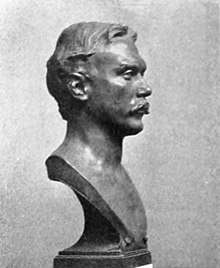
Schofield met Muriel Redmayne, an English visitor to Philadelphia in either 1895 or 1896, and they soon married.[lower-alpha 3] He had early professional success with restrained Pennsylvania winter landscapes,[lower-alpha 4] painted in a Tonalist style "characterized by muted colors and soft, flowing brushwork."[10] In 1901, he and his pregnant wife moved from Philadelphia to her home town of Southport, North West England.[18] They had two sons, Seymour and Sydney. The family lived for a time in Brittany,[19]:286 and from 1903 to 1907 in the coastal town of St. Ives, Cornwall.[19]:286 Schofield would spend half of the year in Philadelphia, away from his family, painting his signature autumn and winter scenes.[7] He maintained this routine from 1902 to 1937, except during World War I.[10]
When in Philadelphia, Schofield would often stay with his brother Albert and family in the Chestnut Hill neighborhood of the city.[20] This was a short walk from the Valley Green section of Fairmount Park, and the picturesque Wissahickon Creek became the subject of a number of his paintings.[20]
| “ | Zero weather, rain, falling snow, wind—all these things to contend with only make the open-air painter love the fight. — W. Elmer Schofield[19] | ” |
Schofield enjoyed a friendly rivalry with Edward Redfield, a founder of the New Hope School of landscape painting. Both worked en plein air even in the coldest weather, both favored large canvases and preferred to finish a work in a single day, and the pair sometimes painted together. Observing Redfield, Schofield gradually abandoned his early technique in favor of a more dynamic style "of expressionistic brushwork and a greater sense of form, structure and patterning that itself border[ed] on Post-Impressionism."[10] Redfield and Schofield had a major falling out that ended their friendship.[lower-alpha 5] Painter Emile Gruppe witnessed the results of Schofield's transformation in the first decade of the 20th century: "I can still remember the great National Academy shows. Three painters dominated the walls: Edward Redfield, Daniel Garber and Elmer Schofield. They all worked boldly and with wonderful color – and you never critically compared them, for you loved each one when you stood in front of his canvas."[21]
Schofield painted in a brighter palette after World War I, applying this new approach to snow scenes, to coastal scenes of Cornwall, and to landscapes of California, New Mexico and Arizona.[10]
Schofield especially liked to paint on sunny days. Even in canvases where sunlight isn't a tangible presence, it often might as well be, because the brightness of the colors and the clean delineations between objects give the illusion of light even when it's not really there. As one of Schofield's contemporaries put it, "He is an open-air man, wholesome, healthy, and his art, sane and straightforward, reflects his temperment."
Schofield took great joy in what he saw. His trees, for example, are sinuous, sensuous, dancing entities, full of rhythm and life. He could transform an ordinary English village into an organized yet delightful casual conglomeration of lines, angles, planes, and shapes. He saw nature in bright colors—light greens, pale blues, intense whites dappled with gray shadows—and he never lost his sense of wonder at the beauty of the natural world. As he put it, "Nature is always vital, even in her implicit moods, and never denies a vision to the real lover."[3]
World War II ended Schofield's annual trips to the United States.[10] He spent his last years living and painting in Cornwall.[10]
Personal
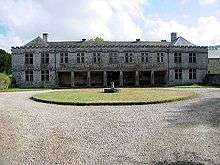
In 1915, at age 48, Schofield enlisted as a private in the British Army during World War I. He saw action in the Battle of the Somme, and was transferred from infantry to artillery. He rose to the rank of major.[8]
After the war, Schofield and his wife lived in Perranporth, Cornwall, and in Otley, Suffolk from 1925 to 1937.[2]:495 They purchased "Godolphin Manor" in Breage, Cornwall in September 1937, which their architect son Sydney restored.[8] Many of Schofield's late paintings depict the manor and its gardens. The couple moved to the smaller "Gwedna House" on the same property in 1941, and gave the manor house to Sydney and his bride.[8]
Walter Elmer Schofield died of a heart attack at "Gwedna House" on March 1, 1944.[9] His body was temporarily buried in England, and exhumed and reburied in Philadelphia at the Church of St. James the Less, after World War II.[7] His wife Muriel, who survived him by 16 years, was buried beside him. In addition to being an architect, Sydney Elmer Schofield (1901–1983), was a portrait painter.[22] Sydney's widow sold "Godolphin Manor" to the National Trust in 2007.[23]
Exhibitions, awards and honors
Schofield exhibited at a number of international expositions: the 1900 Exposition Universelle in Paris (honorable mention for Night in January);[24] the 1901 Pan-American Exposition in Buffalo, New York (silver medal for Autumn in Brittany);[25] the 1904 World's Fair in St. Louis, Missouri (silver medal for Winter Morning);[8]:340 the 1910 Exposición Internacional del Centenario in Buenos Aires, Argentina (gold medal for The First Days of Spring);[26] the 1915 Panama-Pacific Exposition in San Francisco (silver medal for The Hilltop);[3]:329 and the 1926 Sesquicentennial Exposition in Philadelphia (silver medal).[27]
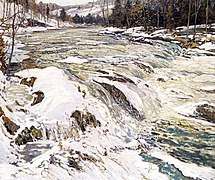
The Society of American Artists awarded Schofield its 1900 Webb Prize of $300 (best landscape exhibited by an American artist under 40) for Autumn in Brittany.[28] He exhibited regularly at the National Academy of Design in New York City. NAD awarded him its 1901 First Hallgarten Prize for Winter Evening; its 1911 Inness Gold Medal for February Morning; and its 1920 Altman Prize for The Rapids.[27] He exhibited at the Pennsylvania Academy of the Fine Arts most years from 1891 to 1937, and posthumously in 1946.[29] PAFA awarded him its 1903 Jennie Sesnan Gold Medal (best landscape painting exhibited by an American artist) for Breezy Day, Early Autumn; and its 1914 Temple Gold Medal (best oil painting exhibited by an American artist) for The Hill Country.[30] The Carnegie Institute in Pittsburgh awarded him its 1900 honorable mention (4th prize) for January Woods,[31] and its 1904 gold medal and $1,500 prize for Center Bridge - Across the River.[27] The National Arts Club in New York City awarded him its 1913 gold medal and $1,000 prize for The Spring Thaw.[27] The Memorial Art Gallery in Rochester, New York hosted a one-man-show of his paintings in February and March 1915.[32] Schofield visited the exhibition, and painted two works during his stay, both of which are now in the gallery's collection.[33] The Art Institute of Chicago hosted a one-man-show of his paintings in 1920,[34] and awarded him its 1921 Spalding $1,000 Prize for Morning Light.[27] The Corcoran Art Gallery in Washington, D.C. hosted 3 one-man-shows of Schofield's paintings – in 1912, 1920 and 1932 – and awarded him its 1926 silver medal and $1,500 Clark Prize for Cliff Shadows.[35] Schofield also exhibited at the Royal Academy of Arts in London.[8]:281
Schofield was elected an Associate of the National Academy of Design in 1902 – Robert Henri painted his diploma portrait[2]:263 – and an Academician in 1907.[34] He was elected a member of the Society of American Artists in 1904,[35] and to the National Institute of Arts and Letters in 1908.[36] He was a member of the Art Club of Philadelphia; and of the Century Association, the National Art Club, and the Salmagundi Club in New York City.[34] He was elected an honorary member of the Royal Society of British Artists in 1907, and elected to the Royal Institute of Oil Painters in 1910.[16] He was a member of the Chelsea Arts Club in London,[34] and the St Ives Society of Artists in Cornwall.[8]
Posthumous exhibitions
The National Academy of Design mounted a memorial exhibition of his work in 1945,[2]:495 as did the Woodmere Art Museum that same year.[20] The Brandywine River Museum mounted a 1983 retrospective exhibition: Walter Elmer Schofield, Bold Impressionist.[37] The Payne Gallery at Moravian College mounted a 1988 retrospective exhibition: W. Elmer Schofield: Proud Painter of Modest Lands.[38] The Trout Gallery at Dickinson College mounted a 2015 exhibition, Schofield: Impressionist Landscapes.[39] The Woodmere Art Museum mounted a 2015 retrospective exhibition – Walter Elmer Schofield, International Impressionist – that focused on his career on both sides of the Atlantic;[20] and a small 2017 exhibition of recent gifts from the artist's descendants.[20]
Works
Schofield's works are in the collections of the National Gallery of Art, the Metropolitan Museum of Art, the Smithsonian American Art Museum, the Art Institute of Chicago, the Philadelphia Museum of Art, the Pennsylvania Academy of the Fine Arts, the Fine Arts Museums of San Francisco, the Los Angeles County Museum of Art, the Woodmere Art Museum, and other American museums.[1] In Europe, his works are in the collections of the Godolphin Estate in England, and the Musée d'Orsay in France.[1] One of his paintings is in the Juan Manuel Blanes Museum in Uruguay.[19]:281
The auction record for a Schofield work was set on December 1, 2004, when Rapids in Winter sold for US$456,000 at Sotheby's NY.[40]
Selected works
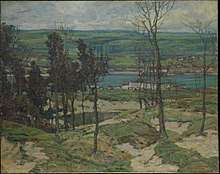
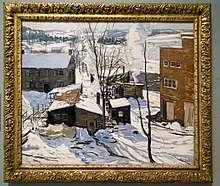
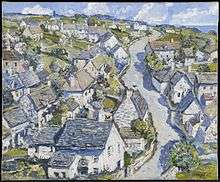
- Winter (1899), Pennsylvania Academy of the Fine Arts, Philadelphia.[41]
- Winter Evening (1899), Muriel and Philip Berman Museum of Art, Ursinus College, Collegeville, Pennsylvania.[42] Awarded NAD's 1901 First Hallgarten Prize.
- Autumn in Brittany (c.1900), Albright-Knox Art Gallery, Buffalo, New York.[43] Awarded the Society of American Artists' 1900 Webb Prize, and a silver medal at the 1901 Pan-American Exposition.
- Breezy Day, Early Autumn (c.1902), Reading Public Museum, Reading, Pennsylvania.[44][45] Awarded PAFA's 1903 Sesnan Gold Medal.
- Across the River (c.1904), Carnegie Art Museum, Pittsburgh, Pennsylvania[46][47] Awarded the Carnegie Institute's 1904 gold medal.
- Sand Dunes near Lelant, Cornwall (1905), Metropolitan Museum of Art[48]
- Winter in Picardy (1907), Philadelphia Museum of Art[49]
- Evening along the Shore, St. Ives (c.1907), National Academy of Design, New York City[2]:495
- Old Mills on the Somme (c.1907), Indianapolis Museum of Art[50][51]
- The Lock (1908).[52] Ex collection: St. Louis Art Museum[53]
- On the Canal, Bruges (1908), private collection
- The Landing Stage, Boulogne (1908‐09), Cincinnati Art Museum[54]
- The First Days of Spring (c.1910), Juan Manuel Blanes Museum, Montevideo, Uruguay.[19]:281 Awarded a gold medal at the 1910 Exposición Internacional del Centenario in Buenos Aires.
- Ebb Tide (c.1912), National Arts Club, New York City.[10]
- Frosty Morning (1913),[55] Avery Galleries, Bryn Mawr, Pennsylvania.[56] Ex collection: Montclair Art Museum[lower-alpha 6]
- Covered Bridge on the Schuylkill (The Red Bridge) (c.1913), Brandywine River Museum, Chadds Ford, Pennsylvania[59][60]
- The Hill Country (c.1913), Woodmere Art Museum, Philadelphia.[61] Awarded PAFA's 1914 Temple Gold Medal.
- The Spring Thaw (c.1913), Biggs Museum of American Art, Dover, Delaware.[62] Awarded the National Arts Club's 1913 gold medal.
- The Powerhouse, Falls Village, Connecticut (c.1914), Art Institute of Chicago[63]
- Building The Coffer-dam (c.1914), Art Institute of Chicago[64]
- The Rapids (c.1914), Smithsonian American Art Museum.[65] Awarded NAD's 1920 Altman Prize. Ex collection: Brooklyn Museum[lower-alpha 7]
- The Old Covered Bridge (c.1914), Rockford Art Museum, Rockford, Illinois[67]
- The Lower Falls (1915), Memorial Art Gallery, University of Rochester, Rochester, New York[33][68]
- In the Dugway (1915), Memorial Art Gallery, University of Rochester, Rochester, New York[69]
- Mining Village in Cornwall (c.1920), Minneapolis Institute of Arts[70]
- Morning Light (Lumiere du Matin) (c.1921), Musée d'Orsay, Paris, France[71][72] Awarded the Art Institute of Chicago's 1921 Spalding Prize.
- Cliff Shadows (1921), National Gallery of Art, Washington, D.C.[73][74] Awarded the Corcoran Art Gallery's 1926 silver medal and Clark Prize.
- The Birches (The Ravine) (1922), Fine Arts Museums of San Francisco[75]
- Sunlit Cove (1923), High Museum of Art, Atlanta, Georgia[76][77]
- The Red Barn (1930), Payne Gallery, Moravian College, Bethlehem, Pennsylvania[78][79]
- Cornish Coast (c.1934), James A. Michener Art Museum, Doylestown, Pennsylvania[80]
- Tujunga Canyon (c.1934-35), Los Angeles County Museum of Art[81]
- Rapids in Winter (c.1936), private collection.[82] Sold at Sotheby's NY, December 1, 2004, realized $456,000 (auction record).
 Winter in Picardy (1907), Philadelphia Museum of Art
Winter in Picardy (1907), Philadelphia Museum of Art On the Canal, Bruges (1908), private collection
On the Canal, Bruges (1908), private collection Old Mills on the Somme (c.1909), Indianapolis Museum of Art
Old Mills on the Somme (c.1909), Indianapolis Museum of Art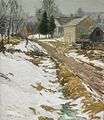 Frosty Morning (1913), Ex collection: Montclair Art Museum
Frosty Morning (1913), Ex collection: Montclair Art Museum- Tujunga Canyon (c.1934-35), Los Angeles County Museum of Art
Notes
- ↑ Henri played host to regular artists' gatherings at his studio, occasions to socialize, drink, sketch, talk about art, and give artistic criticism of one another's work. Henri urged the young men he brought together to read Whitman and Emerson, William Morris Hunt's Talks on Art and George Moore's Modern Painting, and to think about the need to create a vigorous new American art that spoke to their time and experience. These gatherings were the inspirational beginning of what became known as the Ashcan school of American art.[12]
- ↑ Schofield, Henri and Koopman had trained in Paris, this was Glackens's first visit. They came to study the French Impressionists, to paint, and to each develop his own style.[13] Grafy was on his honeymoon, and had taken a sabbatical from teaching at PAFA to work on a major anti-war sculpture, that became The Vultures of War.[14] Schofield painted in Paris, Britany and Fontainebleau.[8]
- ↑ There is disagreement among scholars about the year and location of their wedding. Stephanie L. Herdrich states that it was in 1897, and implies that it was in Philadelphia.[7] David Tovey states that it was in October 1897, in England.[8] The Suffolk Artists website states that they were "married at Ormskirk, Lancashire in 1896."[16]
- ↑ "January Evening and Winter, snow studies in the woods, deserve particular attention; for they are by a young painter, W. Elmer Schofield, a pupil of the Pennsylvania Academy, who has recently returned from supplementing his studies in France. They recall no one else's treatment of snow subjects. Nature has evidently been his inspiration; he has studied her sincerely, with much feeling for her color and spaciousness, and expressed what he has found in a vigorous and simple way, without any attempt to display what he could have done with it had he been so minded. In this way, he has secured both individuality and sentiment."[17]
- ↑ Schofield won the 1904 Carnegie gold medal for Across the River. Redfield claimed that Schofield had copied the painting's composition from one of his works.[7] Art historian Thomas Folk suspects that Schofield never painted in New Hope again.[15]
- ↑ Frosty Morning was deaccessioned by the Montclair Art Museum in 2009, and auctioned at Christie's NY, 20 May 2009.[57] It sold for $30,000 plus buyer's premium.[58]
- ↑ The Brooklyn Museum hosted the National Academy of Design's 1920 Spring Exhibition, and NAD donated The Rapids as a token of thanks.[66] The Brooklyn Museum deaccessioned the painting by the 1950s.[65]
References
- 1 2 3 "Walter Elmer Schofield - Artworks". The Athenaeum. Retrieved February 18, 2017.
- 1 2 3 4 5 6 7 David B. Dearinger, Paintings and Sculpture at the National Academy of Design, Volume 1: 1826–1925 (National Academy of Design, Hudson Hills Press, 2004).
- 1 2 3 Brian H. Peterson, "The Painterly Voice," in William H. Gerdts, et al., Pennsylvania Impressionism (University of Pennsylvania Press, 2002), pp. 34-35.
- ↑ Benjamin Schofield, from Find-a-Grave.
- ↑ Mary Wollstonecraft Schofield, from Find-a-Grave.
- ↑ Edwin Troxwell Freedly, Philadelphia and Its Manufactures (Philadelphia: Edward Young, 1859), p. 261.
- 1 2 3 4 5 6 Stephanie L. Herdrich, "Walter Elmer Schofield," in Helene Barbara Weinberg, American Impressionism and Realism: A Landmark Exhibition from the MET (Metropolitan Museum of Art, 2009), p. 310.
- 1 2 3 4 5 6 7 8 9 10 11 David Tovey, Creating A Splash - The St. Ives Society of Artists - The First 25 Years (1927–1952) (Hilmarton Manor Press, 2003).
- 1 2 "Walter Elmer Schofield papers, 1885–1974". Archives of American Art. Retrieved February 18, 2017.
- 1 2 3 4 5 6 7 8 Carol Lowrey, A Legacy of Art: Paintings and Sculptures by Artist Life Members of the National Arts Club (National Arts Club, Hudson Hills Press, 2007), pp. 172-73.
- ↑ Constance Kimmerle, Edward Redfield: Just Values and Fine Seeing (University of Pennsylvania Press, 2004), pp. 22–23.
- ↑ William H. Gerdts, William Glackens, (New York: Abbeville Press, 1996), p. 13.
- 1 2 Ira Glackens, William Glackens and the Eight: The Artists Who Freed American Art (New York: Horizon Press, 1984), pp. 69–70.
- ↑ Susan James-Gadzinski and Mary Mullen Cunningham, "Charles Grafly, 1862–1929," in American Sculpture in the Museum of American Art of the Pennsylvania Academy of the Fine Arts (PAFA, 1997), pp. 118–19.
- 1 2 Thomas Folk, The Pennsylvania School of Landscape Painting - An Original American Impressionism, exhibition catalogue, (Allentown Art Museum, 1984), p. 47.
- 1 2 Walter Elmer Schofield, 1867 - 1944, from Suffolk Artists.
- ↑ Charles H. Caffin, The Artist: An Illustrated Monthly vol. 24 (February 1899), (New York: Truslove, Hanson & Comba, 1899), p. xxviii.
- ↑ Sidney Elmer Schofield, from Cornish Artists.
- 1 2 3 4 5 C. Lewis Hind, "An American Landscape Painter: W. Elmer Schofield," The International Studio, vol. 48, no. 191 (January 1912), pp. 280–89.
- 1 2 3 4 5 Walter Elmer Schofield, from Woodmere Art Museum.
- ↑ Emile Gruppe, Gruppe on Color (New York: Watson-Guptill Publications, 1979), p. 7.
- ↑ Sydney Elmer Schofield, from Suffolk Artists.
- ↑ "Visitor Information - Godolphin". National Trust. Retrieved 2018-10-10.
- ↑ The Artist: An Illustrated Monthly Record of Arts, Crafts and Industries, vol. 28, no. 246 (July 1900), p. x.
- ↑ Catalogue of the Exhibition of Fine Arts: Pan-American Exposition (Buffalo, 1901), pp. 33, 42, 56.
- ↑ Exposición Internacional de Bellas Artes: Catálogo Oficial Ilustrado (Moneda esquina San Antonio, 1910), p. 62.
- 1 2 3 4 5 "Walter Elmer Schofield - Awards and Appointments," from James A. Michener Art Museum.
- ↑ Appletons' Annual Cyclopaedia and Register of Important Events (D. Appleton & Company, 1901), p. 231.
- ↑ Peter Hastings Falk, ed., The Annual Exhibition Record of the Pennsylvania Academy of the Fine Arts, Volume 2, 1876-1913 (Madison, CT: Sound View Press, 1989), p. 428.
- ↑ Peter Hastings Falk, ed., The Annual Exhibition Record of the Pennsylvania Academy of the Fine Arts, Volume 3, 1914-1968 (Madison, CT: Sound View Press, 1989), p. 415.
- ↑ The Sketch Book, vol. 5, no. 2 (October 1905), Chicago & New York, pp. 98-99.
- ↑ Exhibition of Paintings by W. Elmer Schofield and a Collection of Paintings Representative of The Modern Movement in American Art. The Memorial Art Gallery. February 16 to March 7, 1915.
- 1 2 Lower Falls, from Memorial Art Gallery.
- 1 2 3 4 "W. Elmer Schofield," Seven Special Exhibitions, from December 17, 1920 to January 18, 1921 (Art Institute of Chicago, 1920), p. 4.
- 1 2 Dorothy W. Phillips, A Catalogue of the Collection of American Paintings in the Corcoran Gallery of Art, Volume 2 (Washington, D.C.: Corcoran Gallery of Art, 1973), p. 72.
- ↑ Deceased Members, from American Academy of Arts and Letters.
- ↑ Thomas Folk, Walter Elmer Schofield, Bold Impressionist, exhibition catalogue, (Brandywine River Museum, 1983), from Amazon.
- ↑ Valerie Livingston, W. Elmer Schofield: Proud Painter of Modest Lands, exhibition catalogue, (Moravian College, 1988).
- ↑ Schofield: Impressionist Landscapes, (PDF) from Trout Gallery.
- ↑ Rapids in Winter, from Sotheby's Auctions.
- ↑ Winter, from PAFA.
- ↑ Winter Evening, from The Athenaeum.
- ↑ Autumn in Brittany, from Library of Congress.
- ↑ Breezy Day, Early Autumn, from Reading Public Museum.
- ↑ Breezy Day, Early Autumn, from SIRIS.
- ↑ Across the River, from Carnegie Art Museum.
- ↑ Across the River, from SIRIS.
- ↑ Sand Dunes near Lelant, Cornwall, England, from Metropolitan Museum of Art.
- ↑ Walter Elmer Schofield, from PMA.
- ↑ Old Mills on the Somme, from Indianapolis Museum of Art.
- ↑ Old Mills on the Somme, from SIRIS.
- ↑ The Lock, from SIRIS.
- ↑ The Lock (at auction), from SIRIS.
- ↑ The Landing Stage at Boulogne, from SIRIS.
- ↑ Frosty Morning, from SIRIS.
- ↑ Frosty Morning, from Avery Galleries.
- ↑ Update on Montclair Deaccessions, from Culture Grrl.
- ↑ Frosty Morning, from Chistie's NY.
- ↑ Covered Bridge on the Schuylkill, from Brandywine River Museum.
- ↑ Covered Bridge on the Schuylkill, from SIRIS.
- ↑ Walter Elmer Schofield, from Woodmere Art Museum.
- ↑ The Spring Thaw, from SIRIS.
- ↑ "Schofield, Walter Elmer". Art Institute of Chicago. Retrieved February 18, 2017.
- ↑ Building the Coffer-dam, from AIC.
- 1 2 The Rapids, from Smithsonian American Art Museum.
- ↑ The Brooklyn Museum Quarterly, vol. 7 (1920), p. 149.
- ↑ The Old Covered Bridge, from Rockford Art Museum.
- ↑ The Lower Falls, from SIRIS.
- ↑ In the Dugway, from Memorial Art Gallery.
- ↑ Mining Village in Cornwall, from Minneapolis Institute of Arts.
- ↑ Lumiere du Matin, from SIRIS.
- ↑ Morning Light, from The Athenaeum.
- ↑ Cliff Shadows, from National Gallery of Art.
- ↑ Cliff Shadows, from SIRIS.
- ↑ The Birches (The Ravine), from Fine Arts Museums of San Francisco.
- ↑ Sunlit Cove, from High Museum of Art.
- ↑ Sunlit Cove, from SIRIS.
- ↑ The Red Barn, from The Athenaeum.
- ↑ The Red Barn, from SIRIS.
- ↑ Cornish Coast, from James A. Michener Art Museum.
- ↑ Tujunga Canyon, from LACMA.
- ↑ Rapids in Winter, from Invaluable.
External links
| Wikimedia Commons has media related to Walter Elmer Schofield. |
- Obituary: The New York Times, March 3, 1944
- Walter Elmer Schofield, at Smithsonian Institution Research Information System
- Walter Elmer Schofield at Find a Grave
